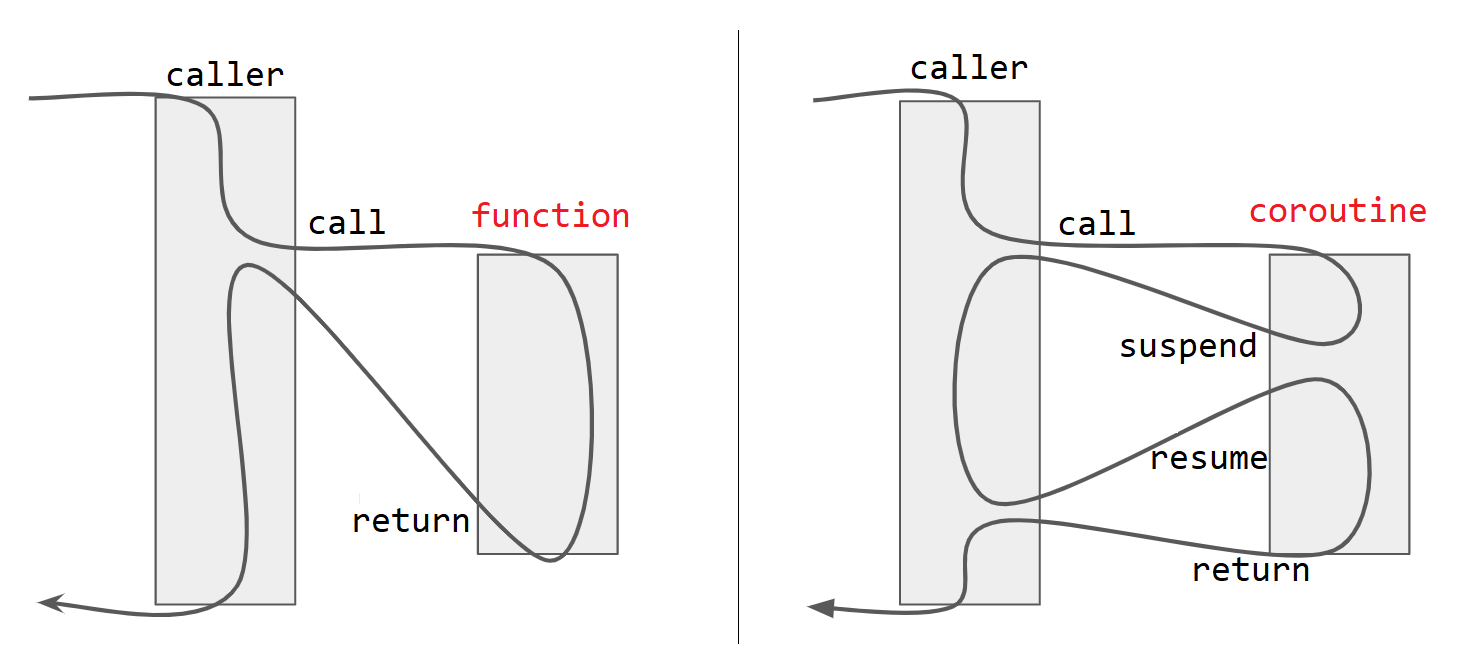Although the function calling was not summarized into the category of context switch generally, it is still a great choice to learn function calling as a warm-up.

(image source: cpp20-coroutine-under-the-hood)
A Simple Example
The function calling gives a promise which the changes to variable doing by the callee would not take effect of the caller (unless deliberately or the variables of callee and caller point to the same memory location).
Here is an example of function calling:
#include <stdio.h>
void inner_function(int a) {
a = 100;
printf("value of a (inside the inner function): %d\n", a);
}
int main() {
int a = 1;
printf("value of a (original): %d\n", a);
inner_function(a);
printf("value of a (after inner function was called): %d\n", a);
}
And the result shows that the value of a of the caller has not been affected by the callee:
value of a (original): 1
value of a (inside the inner function): 100
value of a (after inner function was called): 1
So the main() and inner_function() here are two context, we can switch at will between them without affecting the variables of themselves.
Function Calling in x86 Assembly
The CS and IP register are the foundation to achieve functions callings in x86, where CS (code segment register) stores the memory location of the code segment current executed, and IP (instruction pointer) stores the offset address within the code segment of the memory. Hence CS:IP is used to point to the location of the currently executed code in the memory (it’s a physical address when using the intel 8086 cpu).
So the function calling and returning is basically playing around CS and IP registers, those procedures are thoughtfully packaged into several instructions in the 8086 cp: call and ret/retf.
The call command is used to jump to a function’s entrypoint in the calling manner, it’s equivalent to:
push CS
push IP
jmp <location> # <location> is a register or an raw address
# e.g:
# jmp 2AE3:3
# which makes CS=2AE3H, IP=0003H, cpu will read the next
# instrction from 2AE33H
# jmp ax
# which means "replace the value of IP register with the
# value from ax register"
The ret command provides the ability to return within the same code segment, it’s equivalent to:
pop IP
the retf command provides the ability to return to a different code segment by modifies both CS and IP register:
pop IP
pop CS
After we have call and ret instructions, there is a very important issue must be dealt with: the registers used by subroutine (callee) are very likely also used by the caller, which caused conflicts in the use of registers.
For all registers used by the subroutine, its value must be saved to the stack when the subroutine starts to execute, and then restored before the subroutine returns, in the inverse order.
e.g: (assuming the CX and SI registers are used by the function foo)
foo:
push cx
push si
(execution...)
pop si
pop cx
Calling conventions of C language
The calling convention of C language is consists of there parts:
- How does arguments were passed to the callee?
- How does return values passed back to the caller?
- Who responsible for cleaning up the stack when the callee is going to return?
I summarize some of calling conventions according to the points above, the details of these calling conventions could be found in the references.
| language & platform | calling convention | argument-passing | return values passing | stack cleanup |
|---|---|---|---|---|
| C (x86) | CDECL | passed on the stack in Right-to-Left order | eax register | caller |
| C (x86) | STDCALL | passed on the stack in Right-to-Left order | eax register | callee |
| C (x86) | FASTCALL | passing parameters through registers as much as possible, remaining passed through stack | I don’t know | callee |
| C++ (x86) | THISCALL | passed on the stack in Right-to-Left order | eax register | caller |
| C/C++ (x86-64) | System V AMD64 ABI | passing parameters through registers as much as possible, remaining passed through stack | rax register | callee |
Reference
- C++20 Coroutine: Under The Hood - Vishal Chovatiya
- Assembly 2: Calling convention
- 《汇编语言第三版》- 王爽
- Memory Segmentation in 8086 Microprocessor - GeeksforGeeks
- What is the purpose of CS and IP registers in Intel 8086 assembly?
- x86 Disassembly/Calling Conventions - Wikibooks, open books for an open world
- C to assembly call convention 32bit vs 64bit
- __cdecl
- The 64 bit x86 C Calling Convention